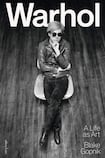
Benedetta Barzini, an heiress and the first Italian model to ever appear on the cover of American Vogue, appears only briefly in Blake Gopnik’s comprehensive study of Andy Warhol, simply called Warhol.
She is the object of obsessive lust for one of Warhol’s desperate stars, Gerard Malanga (he makes a film about her that he’s sure Warhol would dismiss as “corny”).
Decades later, in a candid interview for Warhol’s Interview magazine, Barzini is asked about New York and Warhol himself. She responds, “I thought Andy was ferocious. And very vindictive. He despised all these sons and daughters of very wealthy New York people that were buying his things. And he enjoyed seeing them grasp – and have nothing to do in life, and have no idea who they were. Edie Sedgwick is just one example. He loved that. He thought it was fantastic to see them, like cockroaches, just crawling around with nothing to do except trying to please him. It was interesting. Very interesting.”
This is the version of Andy Warhol that has endured – monosyllabic, controlling, a deathly pale puppeteer in a shabby shock wig. Blake Gopnik’s Warhol isn’t the most critical entry into an already extensive library about Warhol and his dependably self-destructive hangers-on (that accolade belongs to Gary Indiana’s Andy Warhol and the Can That Sold the World in which the critic calls the Soup Cans “a window into the abyss”). Warhol is widely blamed for many of society’s present ills: celebrity culture, selfies, the vulgarism of the art market, the vacuousness of modern New York. Indiana argues, in his slim book, that Warhol perpetuated the idea “that having an image is more rewarding than being a person”’.
Gopnik prefers a softer approach in his roving biography. Some of the most entertaining and lively sections of Warhol focus on the curious and deranged cast of misfits from his Factory-Viva, Candy Darling, Ondine, tragic Edie, all of them suspended forever in the fading silver decor. These characters allowed Warhol to present as the “‘ultimate bad boy” while he continued to live with his mother and, by all accounts, work fanatically. These sections have an obvious charm – like scrolling mindlessly through a gossip website, flicking between reality shows – but they do little to negate Martin Amis’s damning assessment that “Warhol was a fame snob, a looks snob, a weight snob, a height snob and an age snob” (I imagine that Warhol, the son of working-class, immigrant parents, would have managed a wry smile at being called a snob by Martin Amis).
However, it’s in Gopnik’s assessment of Andy’s art that Warhol becomes truly alive and new. Gopnik, the former chief art critic for The Washington Post, treats Warhol’s work not as a mere addition to his celebrity, but the main show. In Gopnik’s assessment Warhol was a serious, consummate artist masquerading as a shallow gadabout. His writing about Warhol’s films, Chelsea Girls and Four Stars particularly, is enlightening. Far from being dull, unedited pornographic nonsense (one magazine writer dismissed a Warhol film as simply being “conversation, homosexual incest, conversation, masturbation, conversation”) Gopnik convinces of their outsized influence on modern, independent cinema.
Motivations
Paul Morrisey, his business partner of sorts, understood Andy’s motivations saying, “Andy makes the kind of movies he likes to make, and the sex is added later because without it people wouldn’t sit through them.” What was Midnight Cowboy but a watered-down Andy Warhol picture? Without him would filmmakers such as Fassbinder, Cassavettes and, even more recently, the Safdie brothers exist? In his films, he came closest to conveying the “real confusions and disjunctions of life” paving the way for more non-judgemental on-screen messiness featuring amateur or non-actors. Sleep, Warhol’s 1964 looped footage of his lover John Giorno’s sleeping body, is still, to this day, oddly electrifying and moving. Similarly, the infamous Screen Tests are a glimpse into his famous subjects at their most vulnerable.
Still a new biography won’t change the bare facts of Warhol’s life. Everything was upended by two shots fired by a disgruntled Valerie Solanas; his work did become embarrassingly empty and commercial. The final picture that emerges from Warhol isn’t of a master manipulator, a perverse voyeur presiding over a decades-long orgy (Gopnik goes to lengths to dispel this particular rumour, detailing several of Warhol’s romantic relationships). The truth is, of course, sadder and less glamorous. One writer who witnessed the scene in the hospital after Warhol’s shooting asked, “How many tears, how many crocodiles?”
Surrounding yourself with a mob of unstable narcissists might guarantee notoriety but not happiness. The Warhol that emerges from Gopnik’s book is far more human, more sensitive and gentler, traumatised by the only person to probably ever have a lasting effect on him – Solanas, who when asked why she shot him responded “because he’s a piece of garbage.” He would never recover from what she did to him. “Andy died when Valerie Solanas shot him,” said the poet Taylor Mead. “He’s just somebody to have at your dinner table now.”
Weighing in at a hefty 1000 pages, Gopnik’s careful, insightful biography – clearly the work of many years of detailed research – is for both the devout and the agnostic. So what is the conclusion? Was Warhol the devil himself or simply a small-business owner? Gopnik acknowledges the unknowability of his subject, a man who sometimes sent doubles, imitation Andys, to play him at college lectures. Regardless, his decades-long impact on the culture remains and, like everything else, he has managed to make his endurance look easy. One punter after walking out of an early screening of Chelsea Girls asked, “Who wants to pay a buck-and-a-half for some creep to tell you how boring and dirty life is?” In 2013, Andy Warhol’s Silver Car Crash sold for $104.5 million.
Nicole Flattery is author of Show Them A Good Time and her novel, Nothing Special, set in Andy Warhol’s Factory, is to be published by Bloomsbury next year










